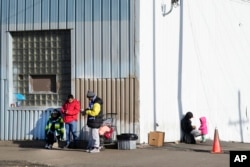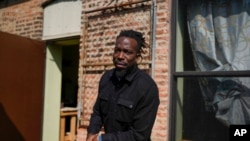The closing of Wadsworth Elementary School in 2013 was a blow to residents of the majority-Black community it served and symbolized the city’s indifference to their interests.
So it added insult to injury when the city reopened Wadsworth last year to provide shelter to hundreds of immigrants without consulting the community. Across Chicago, black residents are frustrated as long-standing needs go unmet while newcomers to the city are cared for with urgency and tax dollars.
“Our voices weren’t valued and we weren’t heard,” said Genesis Young, a lifelong Chicagoan who lives in nearby Wadsworth.
Chicago is one of several major U.S. cities facing a surge in immigration. Texas’ Republican governor has been busing them in to highlight his dissatisfaction with the Biden administration’s immigration policies.
In response to the influx of immigrants, Chicago has spent more than $300 million in city, state and federal funds to provide housing, health care, education and more for the more than 38,000 immigrants who have arrived in the city since 2022 and are in urgent need of help, most of them Is a South American immigrant. The speed at which these funds were raised fueled widespread dissatisfaction among black Chicagoans.
But community leaders are working to ease racial tensions and channel public discontent into agitating for the greater good.
political reaction
The outcry against immigration in Chicago and other Democratic-led big cities has broader consequences in an election year: The Biden administration is now advocating for tighter restrictions on immigration in talks with congressional Republicans.
Young has been feeling “extremely anxious” since the Wadsworth Building reopened as a shelter, with the attendant noise, loitering and around-the-clock police presence. Most importantly, she and other neighbors said it’s a reminder of years of unresolved problems, including high crime rates, unemployment and homelessness.
“I definitely don’t want to sound insensitive to them and their desire for a better life. But if you can suddenly come up with all these millions of dollars to solve their housing problem, why not solve the homeless problem? ?”here? ” said Charlotte Jackson, owner of a bakery and restaurant near the South Loop.
“For a long time we thought this was what had to happen in our community,” said Chris Jackson, who co-founded the bakery with his wife. “This immigration crisis has a lot of people saying: ‘Wait a minute, no, that’s not the case.’ ”
Chicago Mayor Brandon Johnson declined to comment.
After Johnson appealed to Illinois Gov. J.B. Pritzker and President Joe Biden, the city received more than $200 million from the state and federal government to help care for immigrants. The president will travel to Chicago in August to campaign for re-election at the 2024 Democratic National Convention.
some people see opportunity
Some black Chicagoans protested the establishment of shelters in their neighborhoods, but others worked to turn adversity into opportunity.
“Chicago is a microcosm for the rest of the country,” said the Rev. Janet C. Wilson, national executive director of the civil rights group In Search of Excellence. Wilson said black communities have faced decades of discrimination and underinvestment and have reason to be frustrated. She added that the attention immigrants receive is deserved, but it’s also an opportunity for the city to reflect on its responsibility to all underserved communities.
“It’s a moral imperative to take care of everyone,” Wilson said.
After nearly two years of bitter wrangling, the city has begun restricting some immigrant accommodations — prompting a local backlash. The city last month began deporting immigrants who stayed in shelters for more than 60 days, a move that drew condemnation from immigrant rights groups and residents worried about public safety.
Marlita Ingram, a school counselor who lives in the South Shore neighborhood, said she is concerned about the “equitable” sharing of resources between immigrants and long-term residents. But she said she also believes “it doesn’t have to be a competition” and sympathizes with the nearly 6,000 immigrant children currently enrolled in Chicago public schools.
As the potential for racial conflict rises, some activists point to history as a cautionary tale.
In the early 20th century, hundreds of thousands of Southern blacks immigrated to Chicago in search of greater freedom and economic opportunity. Tensions boiled over in 1919 when white Chicagoans accused them of receiving disproportionate resources from the city.
In a wave of racist attacks across American cities that came to be known as the “Red Summer,” white residents burned down large swaths of Chicago’s black neighborhoods and killed 38 black people, including lynchings.
“The response from those white people was, ‘Oh my gosh, no, they’re going to come here and they’re going to take our jobs,’” said Richard Wallace, founder of Equity and Transformation, a black-based organization , a predominantly community-based organization, co-sponsored a March forum aimed at improving dialogue between black and Latino residents.
echoes of the past
When a black Chicagoan complained about the help provided to immigrants, he heard echoes of past prejudices — whether intentional or not. “How did we become like those white people who resisted our people coming to the city of Chicago?” he said.
Labor and immigrant rights organizers have spent years trying to calm divisions among working-class communities. But the immigration crisis has created tensions between the city’s large Mexican-American community and recently arrived immigrants, many from Venezuela.
“If it’s not controlled, we’ll all panic, we’ll all be afraid, and we’ll be backed into a corner,” said Leon Jose Picchieri, executive director of Working Families Solidarity, a predominantly Hispanic labor rights group. Leone Jose Bicchieri) said. “The fact is, this city can’t function without Black people and Latinos.”
Black Americans have a wide range of views on immigration and diversity. The civil rights movement played an important role in pushing for more inclusive immigration policies in the United States.
A March poll from The Associated Press-NORC Center for Public Affairs Research found that about half of black Americans said America’s diverse population makes the country stronger, including 30% who said it makes the country “stronger.”
Many leaders in the black community in and around Chicago have tried to acknowledge the tensions without exacerbating them.
“Our churches are divided on the immigration crisis,” said the Rev. Chauncey Brown, pastor of Second Baptist Church in Maywood, Ill., a predominantly black suburb of Chicago where some immigrants live in shelters In the place.
Brown said there has been a noticeable increase in the number of non-English speakers on the benches, many of whom identify themselves as immigrants in need of food and other services. Some church members warned him against publicly supporting immigrants or allocating more church resources to them. But he said the Bible’s teaching on the issue is clear.
“When strangers come into your land, you take care of them as you would your own,” he said.
Follow us on Google news ,Twitter , and Join Whatsapp Group of thelocalreport.in


